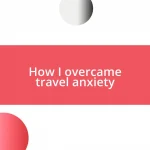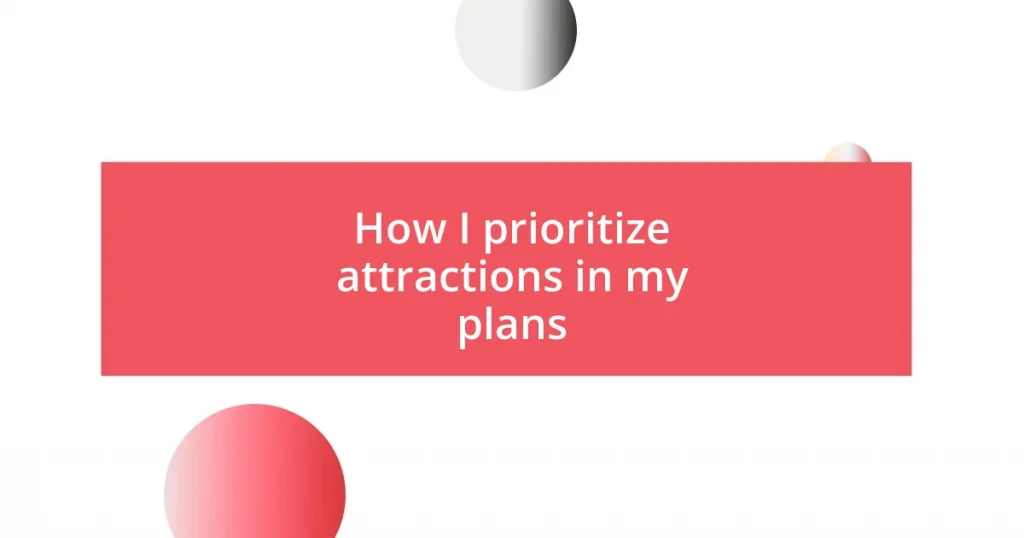Key takeaways:
- Prioritizing attractions involves aligning personal interests, emotional connections, and recommendations from friends, enhancing the travel experience.
- Effective planning includes researching attractions in advance, creating comparison tables, and allowing flexibility in the itinerary for spontaneous discoveries.
- Striking a balance between popular sites and hidden gems enriches travel experiences, providing deeper cultural insights and memorable moments.
- Adjusting plans on the go can lead to unexpected and rewarding experiences, emphasizing the importance of flexibility during travel.

Understanding attraction priorities
When it comes to prioritizing attractions, I’ve learned that the key lies in aligning my interests with what truly matters to me during a trip. For example, on a recent vacation, I found myself torn between museums and outdoor activities, but ultimately, my love for nature won out. Isn’t it fascinating how our personal preferences shape these decisions?
Emotional connections play a big role in my decision-making process. I vividly remember a trip where I chose to explore a small, local festival over a major tourist attraction. That choice not only allowed me to immerse myself in the culture but also brought me joy in ways I hadn’t expected. How often do you choose the path less traveled and discover something unforgettable?
Sometimes, I also consider the stories my friends share about their experiences. When a friend raved about a hidden gem that showcased local art, I prioritized that over more well-known spots. It makes me wonder: how do others’ narratives influence our own plans? Our choices often become more meaningful when they are enriched by the insights and experiences of those we trust.

Factors influencing attraction choices
When deciding which attractions to prioritize, I often reflect on what resonates with me personally. For instance, I recall a time when I stood at a crossroads between visiting a famed historical site and attending an intimate concert by a local band. The allure of live music, combined with the chance to experience authentic local culture, ultimately swayed my choice. It’s moments like these that remind me how deeply our passions can guide us.
Several factors shape the attractions I choose:
- Personal interests: Activities that align with my hobbies, like art or hiking, usually take precedence.
- Recommendations: Hearing firsthand experiences from friends or family can drastically shift my plans.
- Cultural significance: I’m drawn to events or sites that tell a unique story or highlight local traditions.
- Emotional connection: Attractions that remind me of special memories often find their way to the top of my list.
- Time constraints: If my schedule is tight, I opt for experiences that are both memorable and logistically feasible.
These elements combine to create a personalized travel experience that truly reflects who I am as a traveler.

Researching attractions in advance
Researching attractions in advance is an essential step in my planning process. I always start by diving into online resources, reading articles, and exploring travel forums. One time, I stumbled upon a blog post about an obscure botanical garden that became the highlight of my trip. By investing a little time upfront, I not only broadened my options but also discovered experiences I wouldn’t have found in a typical guidebook.
When researching, I often make a list of potential attractions, focusing on their unique features and the experiences they offer. For instance, I once had to choose between two popular museums. By comparing their exhibits online, I learned that one had a temporary exhibition on my favorite artist, while the other featured a broader collection. Ultimately, that research helped me decide where to spend my time. Have you ever made a surprising discovery while looking into an attraction?
To keep things organized, I create a comparison table that helps visualize the attractions I’m considering. This allows me to quickly weigh factors like location, entry fees, and unique aspects of each place. It’s this kind of meticulous planning that ensures I don’t miss out on the gems that align perfectly with my interests.
| Attraction | Unique Features |
|---|---|
| Botanical Garden | Rare plant species and tranquil walking paths |
| Art Museum | Exclusive exhibition on a renowned artist |
| Local Festival | Authentic cultural experiences and local food |

Creating a flexible itinerary
Creating a flexible itinerary is crucial to my travel experience. I’ve found that leaving room for spontaneity can lead to some of the most cherished moments. One time, while I had a full day planned, I randomly wandered into a bustling street fair that I’d never heard of before. The aromas of street food and the sounds of live music drew me in for hours, completely replacing my carefully curated plan.
I believe flexibility allows me to embrace the unexpected. Have you noticed how some of the best travel stories come from unplanned adventures? I remember stumbling upon a small art gallery in a quiet alley that was not on my radar. The pieces on display were captivating, and I ended up having an engaging conversation with the artist. If my itinerary had been too rigid, I might have missed that opportunity entirely.
To achieve this balance, I often outline key attractions while deliberately leaving blocks of unscheduled time. This way, I can wander freely and seize any exciting possibilities that come my way. Plus, it’s refreshing not to feel rushed; taking a moment to pause and appreciate my surroundings often enhances my overall travel experience. How do you find ways to stay open while still having a plan?

Balancing popular and hidden gems
Striking a balance between the must-see attractions and the hidden gems is an art I’ve learned to master. I remember visiting Paris for the first time; the Eiffel Tower and Louvre were irresistible draws, but I also made time for a little café tucked away in a narrow street. That café, with its charming facade and homemade pastries, became a cornerstone of my trip, proving that the lesser-known stops can often resonate just as deeply as the iconic landmarks.
In my experience, blending popular attractions with hidden gems creates a fuller, more rewarding journey. I recall a trip to Rome where I visited the Colosseum and Vatican, which were remarkable, but it was the discovery of a tiny sculpture garden in Trastevere that truly captivated me. Not many tourists ventured there, and the peaceful atmosphere allowed me to reflect on the stories that each piece told. This not only enriched my experience but also gave me a unique narrative to share with my friends back home.
I often ask myself, “What makes a place truly memorable?” The answer usually lies in the blend of both well-known sites and those tucked away. It’s easy to get swept up in the excitement of famous destinations, but it’s those unexpected findings—like a local market or a community mural—that offer a genuine glimpse into the city’s soul. This combination has taught me to appreciate not only the grandeur of attractions but also the delicate, intricate details that make travel so transformative. Have you had moments that made you rethink your travel priorities?

Utilizing time and distance effectively
Time and distance are essential components in organizing my travel plans. I’ve learned the hard way that cramming too many attractions into a day can lead to exhaustion rather than enjoyment. During a trip to Amsterdam, I decided to visit multiple museums in one day, only to find myself rushing from one to the next. By the end, I was too tired to appreciate any of them fully, which was a valuable lesson for me about pacing.
When I plan my itinerary, I consciously map out how far apart destinations are. For instance, one day in Kyoto, I clustered my visits to sites like Kinkaku-ji and Ryoan-ji, which helped me navigate easily without losing precious time on transportation. It’s remarkable how much more enjoyment I find when I’m not constantly checking the clock or worrying about making it to the next place. This strategic approach has allowed me to savor each moment, particularly those spent in beautiful gardens or tranquil temples.
Have you ever felt rushed during your travels? I certainly have, and it often diminishes the experience. I now limit my daily goals to two or three key attractions, providing ample time to wander around and breathe in the local culture. I recall one leisurely afternoon in Barcelona, where I had no agenda and simply meandered through the Gothic Quarter. The unexpected encounter with street musicians turned an ordinary stroll into a magical moment. Balancing time and distance doesn’t just enhance my trip; it nurtures my soul.

Adjusting plans on the go
Sometimes, plans don’t unfold as we expect, and that’s perfectly fine. I remember a day in Florence when an unexpected rainstorm hit. Rather than feeling frustrated, I adjusted my plans on the fly. I ducked into a local art shop, where I ended up chatting with the owner about his favorite spots in the city—an impromptu experience that unearthed a hidden art exhibition I would’ve otherwise missed. That moment taught me that flexibility leads to surprises that can be just as rewarding as what I initially set out to see.
Flexibility is key when traveling, and I’ve learned to read the vibe of my surroundings. There have been times when I arrived at a popular site, only to be met with long lines that deterred me. Instead of lingering in disappointment, I’ve turned to explore nearby neighborhoods or spontaneous markets. On one such occasion in Istanbul, wandering from the crowded Hagia Sophia to a small tea shop nearby led me to savor an unusual mint tea blend that became a highlight of my trip. It’s fascinating how a quick decision to pivot can transform the day into something memorable.
Have you ever had to scramble your plans at the last minute? I found that embracing these changes encourages spontaneity and often reveals layers of a destination that planned outings may overlook. Whether it’s following a whim to a lesser-known café or responding to fellow travelers’ recommendations, these adjustments enrich my journeys. After all, travel isn’t just about checking items off a list; it’s about connecting with the heart of a place in the most unexpected ways.















